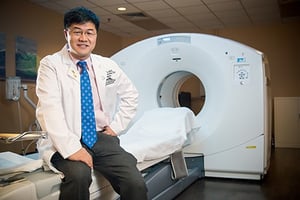Neuroendocrine Tumors (NETs)
You might not know much about neuroendocrine tumors— and understandably so. Neuroendocrine tumors are rare, accounting for less than one percent of all malignant disorders in the United States.
Neuroendocrine cancer develops in neuroendocrine cells which help control your bodily functions. The human body is incredibly complicated. Luckily, most of the time you don’t have to think about how your body processes things like food or air. But eating and breathing are highlight coordinated processes that require very fine control to work well. That’s where neuroendocrine cells come into play. They are “neuro” because they control things and “endocrine” because they work through hormones. They are part of the DIFFUSE NEUROENDOCRINE system with small cells scattered throughout the lungs, digestive organs, and elsewhere.
Abnormal growths in neuroendocrine cells form neuroendocrine tumors. They’re also known as NETs. Some NETs are benign, which means they aren’t cancerous. When cancer is present, it’s called neuroendocrine cancer, no matter where it’s found.
Because these cells are found throughout the body, neuroendocrine cancer can begin anywhere. However, it develops most commonly in a handful of places, including:
- Appendix
- Intestines
- Lungs
- Pancreas
- Stomach
- Rectum
In addition to being rare, neuroendocrine tumors are complex and can be difficult to diagnose. Because of this, the specialists at Rocky Mountain Cancer Centers encourage you to gather and learn as much information about the disease as possible. Please take the time to read through the other pages on our website regarding neuroendocrine tumors.
Neuroendocrine Videos
Neuroendocrine Specialist
At The Neuroendocrine Institute at Rocky Mountain Cancer Centers, we specialize in treating all types and stages of neuroendocrine tumors. Our NET cancer care team is both knowledgeable and experienced, with each physician considered a leader in the diagnosis and treatment of this rare and complex cancer.
Signs & Symptoms of Neuroendocrine Tumors
Diagnosing Neuroendocrine Tumors
It’s important to understand that the diagnostic tests used to detect a neuroendocrine tumor will depend on a variety of factors such as the type of tumor, its location, whether it produces excess hormones, how aggressive it is, and whether it has spread to other parts of the body.
Types of Neuroendocrine Tumors
Being that neuroendocrine tumors (NETs) are rare, it’s likely you don’t know much about them— including the fact that there are different types that are typically classified by the site of origin.
Staging Neuroendocrine Tumors
Treatment Options for Neuroendocrine Tumors
Causes & Risk Factors of Neuroendocrine Tumors
Helpful Tips and Information About Neuroendocrine Tumors From Our Blog

Unique Approaches to Neuroendocrine Cancer
Author: Eric Liu, MD
Though it can appear anywhere in the body, neuroendocrine cancer is a rare disease. Its symptoms can be misleading and diagnosis...

Know the Signs of Pancreatic Cancer
Author: Patrick Eulitt, MD
The early warning signs for pancreatic cancer are sometimes hard to recognize because they are the same as less serious...

Neuroendocrine Cancer Doctor Focuses on “Treating the Patient, Not the Cancer”
A Conversation with Dr. Eric Liu, Chief Medical Director of Surgery for the Neuroendocrine Institute at Rocky Mountain Cancer Centers

Lutathera is Changing the Treatment of Neuroendocrine Tumors
Neuroendocrine tumors (NET) are ones you don’t hear much about because they are rare. Still, for the 12,000 people affected by these very serious...